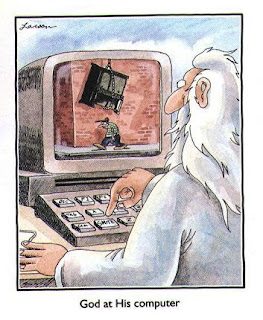St. Louis, MO (Scicasts) - Scientists at Washington University School of Medicine in St. Louis have sequenced the whole genomes of tumors from 50 breast cancer patients and compared them to the matched DNA of the same patients' healthy cells. This is the single largest cancer genomics investigation reported to date, the university claims, and has allowed researchers to find mutations that only occurred in the cancer cells through this comparison process.
The above Circos plot is a visual representation of the genomic disruptions in one of the breast cancers studied. Image by: Matthew J. Ellis, MD, PhD.
This research was presented at the American Association for Cancer Research 102nd Annual Meeting 2011. According to the press report, the researchers uncovered incredible complexity in the cancer genomes, but also uncovered a glimpse of new routes toward personalized medicine.
In all, the tumors had more than 1,700 mutations, most of which were unique to the individual, said Matthew J. Ellis, MD, PhD, professor of medicine at Washington University School of Medicine in St. Louis and a lead investigator on the project. "Cancer genomes are extraordinarily complicated," Ellis continued. "This explains our difficulty in predicting outcomes and finding new treatments."
To undertake the massive task, Washington University oncologists and pathologists at the Alvin J. Siteman Cancer Center at Barnes-Jewish Hospital and Washington University School of Medicine collaborated with the university's Genome Institute to sequence over 10 trillion chemical bases of DNA — repeating the sequencing of each patient's tumor and healthy DNA about 30 times to ensure accurate data.
"The computing facilities required to analyze this amount of data are similar in scale to those of the Large Hadron Collider, used to understand the workings of sub-atomic particles," said Ellis.
The DNA samples came from patients enrolled in a clinical trial that Ellis is leading for the American College of Surgeons Oncology Group. All patients in the trial had what is called estrogen-receptor-positive breast cancer. These cancer cells have receptors that bind to the hormone estrogen and help the tumors grow.
To slow tumor growth and make the tumors easier to remove, patients received estrogen-lowering drugs before surgery. But, for unknown reasons, this treatment does not always work. Twenty-four of the 50 tumor samples came from patients whose tumors were resistant to this treatment, and 26 came from patients whose tumors responded. Comparing the two groups might help explain why some estrogen-receptor-positive breast cancer patients do well with estrogen-lowering drugs, while others do poorly.
Confirming previous work, Ellis and colleagues found that two mutations were relatively common in many of the patients' cancers. One called PIK3CA is present in about 40 percent of breast cancers that express receptors for estrogen. Another called TP53 is present in about 20 percent.
Adding to this short list of common mutations, the researchers found a third, MAP3K1, that controls programmed cell death and is disabled in about 10 percent of estrogen-receptor-positive breast cancers. The mutated gene allows cells that should die to continue living. Only two other genes, ATR and MYST3, harbored mutations that recurred at a similar frequency as MAP3K1 and were statistically significant.
"To get through this experiment and find only three additional gene mutations at the 10 percent recurrence level was a bit of a shock," Ellis explained.
In addition, the team found 21 genes that were also significantly mutated, but at much lower rates — never appearing in more than two or three patients. Despite the relative rarity of these mutations, Ellis stresses their importance.
"Breast cancer is so common that mutations that recur at a 5 percent frequency level still involve many thousands of women," he said.
Ellis points out that some mutations that are rare in breast cancer may be common in other cancers and already have drugs designed to treat them.
"You may find the rare breast cancer patient whose tumor has a mutation that's more commonly found in leukemia, for example. So you might give that breast cancer patient a leukemia drug," Ellis explained.
But such treatment is only possible when the cancer's genetics are known in advance. Ideally, according to Ellis, the goal is to design treatments by sequencing the tumor genome when the cancer is first diagnosed.
"We get good therapeutic ideas from the genomic information," he said. "The near-term goal is to use information on whole genome sequencing to guide a personalized approach to the patient's treatment."
This work builds on previous collaborations between Washington University oncologists and the Genome Institute. In a study published last year in Nature, they reported the complete tumor and normal DNA sequences of a woman with "triple-negative" breast cancer, a particularly aggressive type that is difficult to treat and more common in younger women and African-Americans.
While many mutations are rare or even unique to one patient, Ellis highlighted that quite a few can be classified on the basis of common biological effects and therefore could be considered together for a particular therapeutic approach.
Ellis looks to future work to help make sense of breast cancer's complexity. But these highly detailed genome maps are an important first step. "At least we're reaching the limits of the complexity of the problem," he said. "It's not like looking into a telescope and wondering how far the universe goes. Ultimately, the universe of breast cancer is restricted by the size of the human genome."













